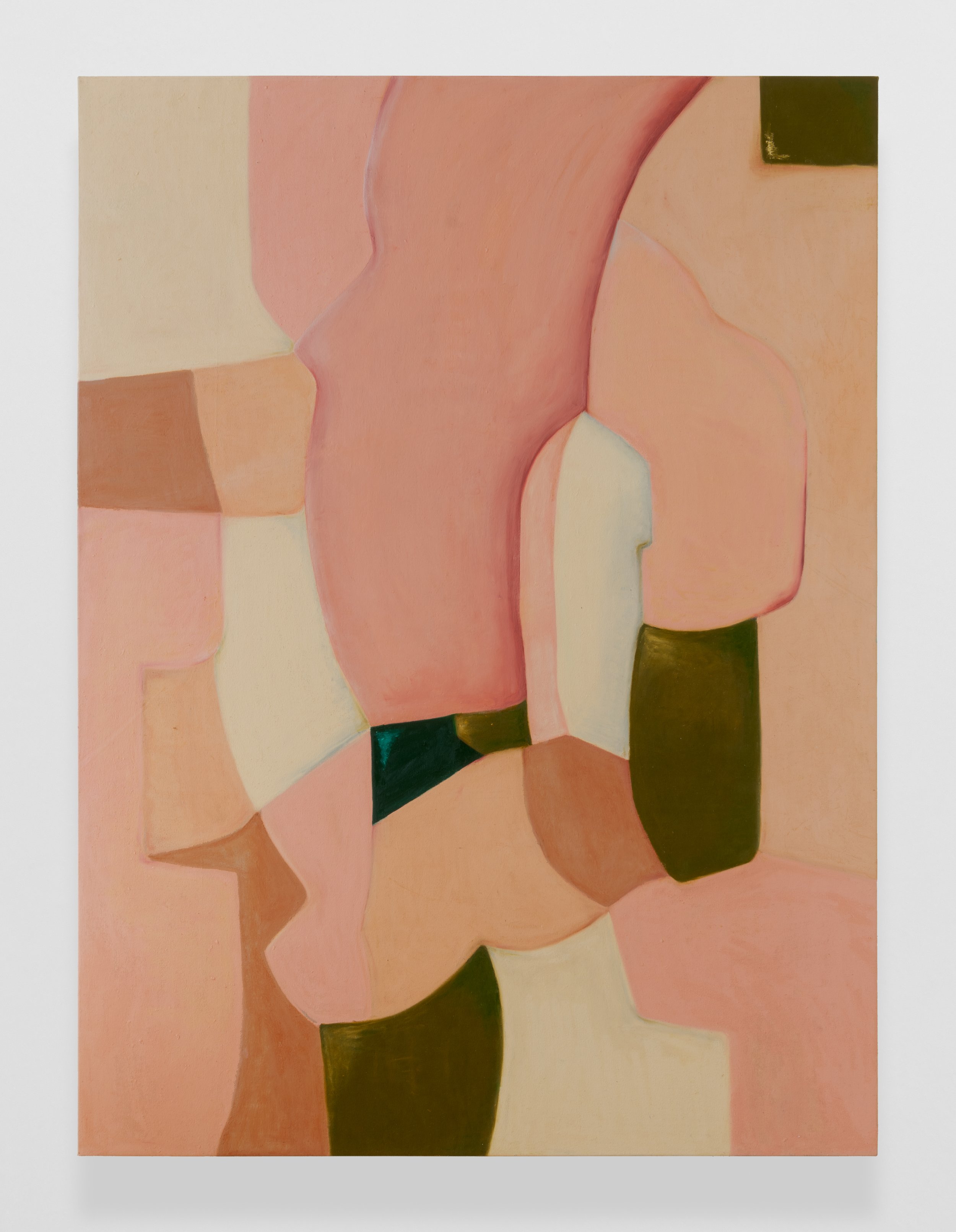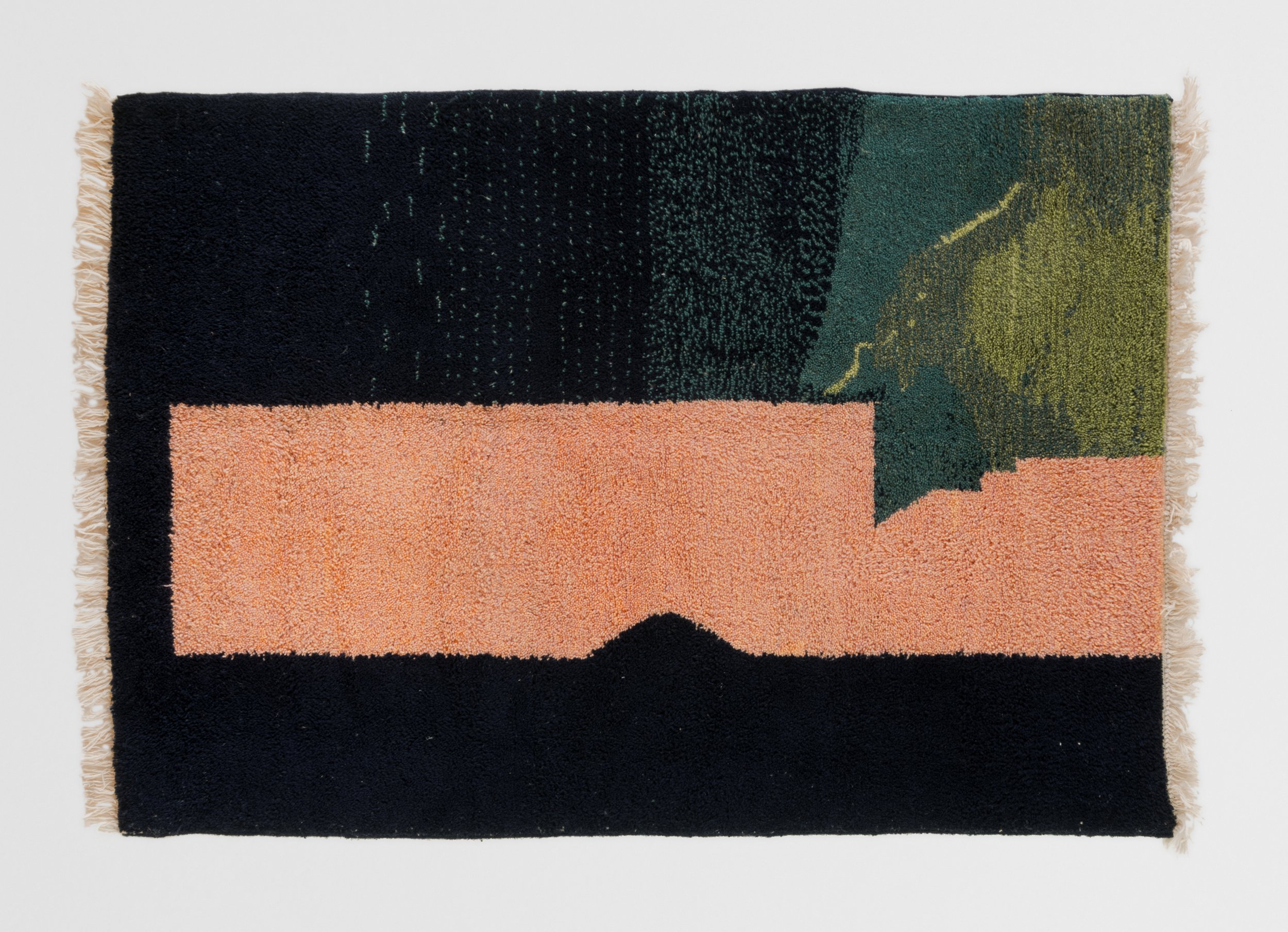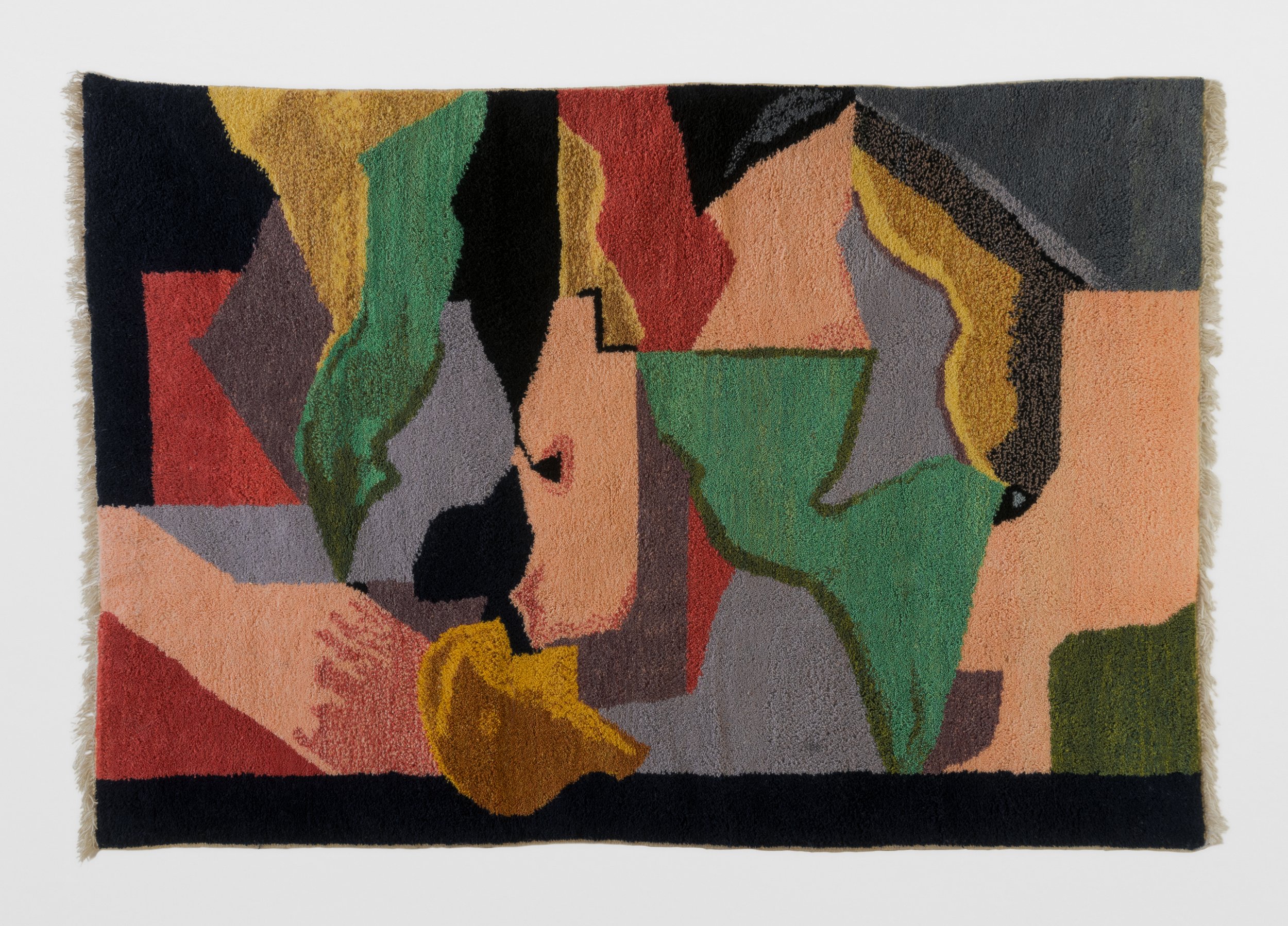Mattea Perrotta
Perdòno, 2023
oil on canvas
57 x 77 in
195.6 x 144.8 cm
interview by Lara Monro
Our primary means of conveying meaning is through spoken and written forms, as well as sign language. But what do we do when faced with language barriers, unable to verbally communicate with another/others? Google translate is one option, but what happens when we use our imagination? Or when we explore the imagination of others through our own unique lens?
The earliest civilizations used cave walls as canvases to share their knowledge, beliefs, and stories. For visual artist, Mattea Perrotta, art has become a way of conveying her secrets and vulnerabilities. It has also become a lexicon to connect with others, often from different countries and communities. During her time in Morocco, challenged with learning Arabic but keen to connect with her hosts, she started using drawings to engage with her companions. It was a familiar and natural way of interpreting the world around her.
A diagnosis of synesthesia at an early age was the catalyst for Perrotta’s need to develop an individual language; mathematical formulas made sense when color coded, as did phone numbers. This subsequently translated into her art form, which began with abstract shapes, defining her earlier career. Perrotta’s practice evolved organically, and in recent years a figurative approach has occupied her canvases as she investigates, questions and challenges the canon of art history referencing the work of Pablo Picasso and Leonardo da Vinci.
This May, Perrotta is exhibiting in her hometown, Los Angeles, for the first time since moving to Europe five years ago. Her solo show, In A Forgotten Tongue, at Praz Delavallade, signifies a turning point for the artist, harking back to an abstract style whilst continuing her investigation into art historical movements; Baroque, Renaissance and Cubism. Each shape within a canvas, or tapestry work, takes on its own vocabulary, distinguished by color and size. As this is Perrotta’s secret language, we are left with subtle signals and our imaginations to interpret the work.
In the following interview, the artist explains why she describes her paintings as being similar to lasagna and what she will be researching during her residency this summer at the American Academy Rome.
LARA MONRO: Can you tell me about how your early diagnosis of synesthesia impacted you creative practice?
MATTEA PERROTTA: School didn’t come naturally to me. Mathematics and spelling were incredibly difficult (and still are). I took exams in other rooms than my classmates to have more time. It was really embarrassing as a kid. I would get so nervous before going to school I would throw up. My mom found this hippie healer outside of Los Angeles to help me deal with my nerves and anxiety in elementary school. She asked me what I enjoyed doing in my spare time and I told her I loved to draw. During our meetings I would draw whilst we spoke. While I was drawing with crayons I told her that when I used a particular color I would see a letter or number—that was my earliest introduction into synesthesia. As I got older and understood what synesthesia meant, I began to use it as a learning tool in school. I essentially was able to cheat my way through academia because I created my own unique language through color that had direct associations with letters and numbers. For example, in math, I would color code on my arms equations or formulas. I still use it to this day when I need to remember phone numbers or how to spell something. Recently I began teaching and I share this with my students who ]might have synesthesia without knowing how it can be used as a learning tool.
Mattea Perrotta
Lingua Madre, 2023
oil on canvas
77 x 57 in
195.6 x 144.8 cm
MONRO: Do you see all your art as your secret language?
PERROTTA: Of course. That's the power of abstraction. You can share your deepest secrets and emotions without giving too much away. It’s incredibly liberating. I resist revealing myself. I’m comfortable with secrets. Abstraction allows me to reveal myself, be vulnerable, whilst still having it be my own. I’ve created a language through abstraction where my secrets can breathe on canvas, but behind a veil of form and color. This is the age of diaries, the talk show, the autobiography, social media. Everyone is an online activist—this self and this experience of selfness in its guises and disguises as it addresses language and as it confers secrets and meanings.
MONRO: Can you tell me how your art form has helped you communicate in the different places you have lived over the years?
PERROTTA: The first memory that comes to my mind is when I was living in Morocco. I was an artist in residence below the Atlas Mountains in this very tiny town called Tahanaout. There were two local artists there, Mohammed Mourabiti and Mahi Binebine. Mohammed ran the residency and Mahi had a studio there. I recommend everyone to get to know their work. I lived on site and painted in another studio during Ramadan. We would gather in the evenings and have dinner together. They spoke in Arabic, I attempted to learn the basics as much as possible, but it wasn’t enough for me to communicate. We began drawing during our dinners to express what we wanted to say. One can imagine how long these dinners were speaking through paper and pencil. I’ll never forget it. We sat in a cave underneath his studio exchanging stories about our homes, and our practice. Art can be an amazing tool for communication when we’re in unfamiliar territory.
MONRO: You will be showcasing a new body of work in your upcoming exhibition, In a Forgotten Tongue. Is the show connected to your last two exhibitions, which examined the canon of art history through the work of Pablo Picasso and Leonardo da Vinci?
PERROTTA: Absolutely. My work always had a heavy influence from Renaissance periods and Picasso’s cubist period. My love for Renaissance painting comes from my time living in Florence after I graduated from [UC] Berkeley. While living there, I studied Renaissance painting and iconography at the Uffizi gallery. In 2018, I moved to Paris and lived near the Picasso museum and would frequent places that he and the surrealists, Dora Maar hung out at. I completely immersed myself in his world and became obsessed with his way of painting and playfulness. That time in Paris for an artist was so special. In recent years—the London years I say—I have been exploring a way to combine the two periods (Baroque and Cubist) into one lens. Research has always been a large part of my practice. Being a traveler keeps me eternally curious about studying the language, traditions and art of where I am, and incorporating that into the work. My paintings are a bit like lasagnas; layers of information I’ve been fed from various places.
Mattea Perrotta
Lo Straniero, 2023
oil on canvas
77 x 57 in
195.6 x 144.8 cm
MONRO: It seems that the works presented in In a Forgotten Tongue are moving away from your more recent figurative pieces?
PERROTTA: Indeed. I’ve been incredibly fortunate to work with galleries that allow me to take risks within my work. I’ve always been someone that’s gone against the grain of what is expected to an extent. I was lucky enough to have my first show with abstract paintings and have it be received well, but after that I wanted to continue to explore different realms. Again, traveling feeds me with so much information that I like to digest it in different ways in my work. In a Forgotten Tongue is a full circle period for me. It’s the first show I’ve done in my hometown in five years since I moved to Europe. It feels like the right time to go back to my earlier abstractions because Los Angeles was that for me. The architecture of the city, the light, the colors, history, immigration of cultures feels like one big abstract painting. Then I left and lived in a few different cities that had heavy influences of Renaissance art from churches to medieval cathedrals. Being able to make abstract paintings incorporating these earlier Renaissance traditions—periods of places I’ve lived through a contemporary lens—feels really on a par with where I am right now in my life and my family’s history.
MONRO: You have created tapestry pieces for this show. Were they created by the same weavers you worked with when living in Morocco in 2017? And, what drew you back to creating tapestry works?
PERROTTA: While I was living in Tahanaout, I became fascinated with materials and mediums. Mohammed and Mahi worked largely with various materials, which opened the floodgates for me to think differently in the studio. On my way there, the airport confiscated my bag of oil paint, so when I arrived in Morocco I didn’t have access to supplies as easily. I began using pigments from the souk as paint. I’d take dirt from my walks and apply it to the canvas. I used the land as a medium. Then, I started thinking more existentially about the painting as a living and breathing being. Morocco is known for their carpets. I met the group of weavers whom I’ve now been working with for the last seven years. The first time I went there with my friend, we got lost three different times, hitch hiked, and had an entire village helping us find the studio. It’s in a very remote town outside of Rabat. I became interested in the way of turning the painting into a livable being, such as a carpet. How it can be enjoyed as a tangible object, eating on it, laying on it, how the painting becomes part of you in a more visceral way. I enjoy the challenge of bringing these instrumental paintings to life, such as my L’Ultima Cena series—making it an interactive and somewhat performative work of art. For the Cena show in Berlin last year, my dear friend Frank Maston composed my paintings into medieval compositions. We released a little cassette for the show. The audio played throughout the entirety of the exhibition. I loved the idea of a painting becoming an invisible feeling that only exists in the ethers. I wanted the paintings to have a voice. My other friend from Bronze Age in London printed a lithograph book of the paintings with text about each apostle. My mother made her famous pasta and we had dinner at the table I had installed for the show. It became a feast of the senses on every level. I really enjoy exploring different territories within my work.
Mattea Perrotta
Perdoni I, 2023
hand dyed, hand sewn wool
57 x 77 in
144.8 x 195.6 cm
MONRO: You will be artist in residence at the American Academy Rome this summer. What inspired you to apply and what will you be working on during your time in the program?
PERROTTA: AAR has been a place where many artists I’ve admired have resided, such as Philip Guston, Bert Long Jr., Martha Boydenn, Jannis Kounellis, and David Hammons, to name a few. The program gives me an opportunity to live within an artistic community and learn about my peers’ process and practices, immerse myself within the history of those who worked there, and challenge myself to find new ways of approaching my studio time. Rome is one of the greatest cities in the world, the history, art, culture—there’s so much beneath those walls that can be explored 1,000 times over again and I feel as though I’ve only ever managed to scratch the surface. Being able to live and work there will allow me to further dive into my research of connecting the dots between Renaissance and contemporary narratives through art, history, and architecture.
MONRO: Being in different places is a huge part of your identity and creative practice; engaging with different cultures and communities. Are you planning to stay and work in Italy post residency?
PERROTTA: I am. I’ll be living and working in Naples full time. My father is Italian and I recently got my dual citizenship. I’ve always felt connected to the culture and my family’s heritage. They grew up in a region called Campobasso in a small village as farmers. It’s a beautiful, tiny mountain town not far from a seaside town called Termoli. They value tradition, the piano piano lifestyle, which in Italian means “slowly, slowly.” I really like to transition into that after living in metropolitan cities, to immerse myself in the humility of it, and see where it takes my paintings. There’s so much more to explore and learn. People and places will forever humble and inspire me to be the best version of myself as a person and artist. I feel very lucky to have the opportunity to live in such a way and share it with others.
Mattea Perrotta
Echoing Dialects, 2023
hand dyed, hand sewn wool
77 x 105 in
195.6 x 266.7 cm
In A Forgotten Tongue is on view through June 24 at Praz Delavallade 6150 Wilshire Blvd
Los Angeles CA 90048





